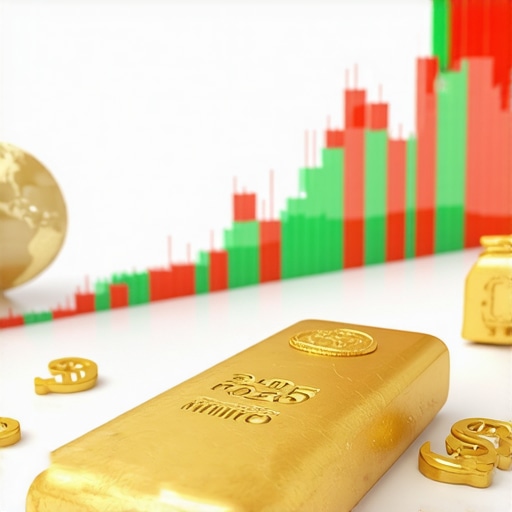Understanding Gold Demand Trends for Investment Success
Investing in gold has long been regarded as a secure way to preserve wealth and safeguard against economic instability. However, to maximize your returns, it’s crucial to understand how to analyze gold demand trends. By comprehensively evaluating the factors influencing demand, you can make informed investment decisions that align with market dynamics.
The Importance of Gold Demand Analysis
Gold demand is influenced by a myriad of factors including economic conditions, geopolitical events, and investor sentiment. By analyzing these demand trends, investors can better predict price movements and optimize their investment strategies. For instance, during periods of economic uncertainty, gold often sees increased demand as investors seek safe-haven assets. Understanding these patterns allows you to anticipate market shifts and position your portfolio accordingly.
Key Factors Influencing Gold Demand
Several elements play a significant role in determining gold demand. The primary factors include:
- Economic Indicators: Metrics such as inflation rates, interest rates, and GDP growth can significantly impact gold demand. For example, high inflation typically drives investors towards gold as a hedge against currency devaluation.
- Central Bank Policies: Central banks around the world hold substantial gold reserves. Their buying or selling activities can influence global gold prices. Monitoring central bank trends can provide insights into future demand.
- Geopolitical Events: Political instability or conflicts often lead to increased gold purchases as investors seek safety. Keeping an eye on global events can help you anticipate spikes in demand.
- Consumer Demand: The jewelry industry is a major consumer of gold. Trends in consumer purchasing behavior, particularly in emerging markets, can provide valuable insights into future demand.
By keeping track of these factors, you can better analyze gold demand trends and make informed decisions. A comprehensive analysis of these elements contributes to a robust investment strategy that can yield significant returns.
Practical Steps for Analyzing Gold Demand
To effectively analyze gold demand trends, consider the following practical steps:
- Research Economic Reports: Stay updated with economic reports and forecasts that influence gold prices. Resources like the U.S. Bureau of Economic Analysis can provide vital data.
- Follow Market News: Regularly check financial news outlets for updates on gold market trends. News related to central bank activities and geopolitical developments can significantly impact gold prices.
- Utilize Analytical Tools: Leverage market analysis tools and platforms that track gold prices and demand metrics. These tools can provide visual insights that enhance your understanding of market trends.
By integrating these steps into your investment approach, you can develop a nuanced understanding of gold demand trends and enhance your ability to make strategic investment decisions.
In conclusion, analyzing gold demand trends is essential for any serious investor looking to maximize returns. By understanding the factors that drive demand and implementing practical analysis strategies, you can position yourself for success in the gold market. For more in-depth insights on gold investing, check out our posts on analyzing gold market trends and gold demand trends in 2025.
Strategies for Analyzing Gold Demand Trends
As an investor, effectively analyzing gold demand trends is crucial for making informed decisions. Utilizing structured strategies can enhance your understanding of market dynamics and improve your investment outcomes. Here are some essential strategies to consider:
1. Monitor Economic Indicators
Staying attuned to economic indicators is a fundamental strategy for analyzing gold demand. Key metrics like inflation rates, interest rates, and employment figures can provide context for gold price movements. For instance, a spike in inflation often correlates with rising gold prices as investors seek to protect their purchasing power. By consistently tracking these economic indicators, you can better predict market reactions and adjust your investment strategy accordingly.
2. Analyze Global Events
Global events play a pivotal role in shaping gold demand. Political instability, natural disasters, and significant economic announcements can all influence market sentiment. For example, during an economic downturn, gold typically sees an increase in demand as it is perceived as a safe-haven asset. To capitalize on these trends, keep a close watch on international news and geopolitical developments. This proactive approach allows you to anticipate market shifts and position your portfolio for optimal returns.
3. Review Central Bank Activities
Central banks are major players in the gold market, holding vast reserves and influencing demand through their buying and selling decisions. Understanding the policies of central banks, particularly regarding gold purchases, can provide valuable insights into future demand trends. Regularly reviewing central bank reports and announcements can help you gauge their impact on gold prices. For instance, if a central bank announces significant gold purchases, it may signal increased demand that could drive prices higher.
4. Leverage Technology for Data Analysis
In today’s digital age, technology can significantly enhance your analysis of gold demand trends. Utilizing data analytics tools can help you track price movements, demand metrics, and supply chain dynamics effortlessly. Platforms that offer real-time data visualizations can provide immediate insights into market fluctuations. By incorporating these technological tools into your investment strategy, you can analyze trends more efficiently and make data-driven decisions.
5. Diversify Your Investment Portfolio
Diversification is a key principle in investment strategy, especially in the volatile gold market. By diversifying your portfolio with various gold-related investments—such as gold ETFs, mining stocks, and physical gold—you can mitigate risks associated with market fluctuations. This approach not only provides exposure to gold but also allows you to benefit from different aspects of the gold market. For more on diversifying with gold, check out our article on diversifying your portfolio with gold.
Understanding the Role of Consumer Demand in Gold Prices
Consumer demand is another critical factor influencing gold prices. The jewelry market, particularly in countries like India and China, significantly impacts overall demand. With a growing middle class in these regions, the appetite for gold jewelry continues to rise. Understanding these consumer trends can help you gauge potential shifts in demand. For instance, during festive seasons, there is often a surge in gold purchases, which can drive prices up. Monitoring these seasonal trends is vital for any investor looking to capitalize on market opportunities.
Exploring Emerging Markets
Emerging markets present a unique opportunity for gold investors. As economies grow and consumer wealth increases, the demand for gold often rises. Countries like India, China, and even parts of Africa are witnessing an uptick in gold consumption. By focusing on these emerging markets, you can identify potential growth areas and adjust your investment strategy accordingly. Additionally, understanding cultural factors influencing gold purchases in these regions can provide deeper insights into market trends.
In summary, analyzing gold demand trends requires a multifaceted approach that includes monitoring economic indicators, global events, and consumer behavior. By integrating these strategies into your investment process, you can enhance your ability to navigate the complexities of the gold market and position yourself for long-term success. For more insights on how to effectively analyze market trends, visit our post on analyzing gold market trends.
Navigating the Complexities of Gold Demand Influencers
Understanding the gold market requires a deep dive into various factors that influence demand. Alongside economic indicators and central bank activities, several other elements impact gold prices and consumer behavior. By grasping these complexities, investors can better position themselves to capitalize on market movements.
The Impact of Geopolitical Tensions
Geopolitical tensions are a potent driver of gold demand. When conflicts arise or trade disputes escalate, investors often flock to gold as a safe-haven asset. For instance, during periods of uncertainty, such as the ongoing tensions between major global powers, gold prices tend to surge as individuals seek security. Keeping abreast of global political climates is crucial for investors who want to anticipate gold price fluctuations. Regularly reviewing news updates and expert analyses can equip you with the knowledge needed to make informed decisions.
Understanding Consumer Behavior in Different Regions
Regional consumer behavior plays a significant role in shaping gold demand. In countries like India and China, cultural traditions drive substantial purchases of gold jewelry, particularly during festivals and weddings. As disposable incomes rise in these regions, demand for gold is expected to increase. For investors, this means that tracking annual buying patterns during key cultural events can provide insights into potential price movements. Furthermore, understanding local preferences for gold investment can help in identifying lucrative opportunities in emerging markets.
Technological Advancements Affecting Gold Trading
With the rise of technology, the gold trading landscape is evolving rapidly. Digital platforms that facilitate gold trading are becoming increasingly popular, allowing investors to buy and sell gold with ease. As technology continues to advance, it is essential for investors to familiarize themselves with these platforms to enhance their trading strategies. Utilizing online resources can also help in analyzing market trends effectively. For more information on trading strategies, visit our post on gold trading techniques.
Long-Term Trends in Gold Demand
While short-term fluctuations are important, it is equally crucial to consider long-term trends that shape the gold market. Over the years, gold has consistently been viewed as a hedge against inflation and currency devaluation. As global economies face uncertainty, the appeal of gold as a stable investment grows. Monitoring long-term economic forecasts and inflation trends will help investors anticipate shifts in gold demand.
The Role of Inflation in Gold Demand
Inflation is a key factor that influences gold prices. When inflation rates rise, the purchasing power of currency declines, prompting investors to seek refuge in gold. As a result, understanding inflation trends and economic forecasts can enhance your investment strategy. For detailed insights on how inflation impacts gold, check out our article on central banks and gold prices.
Environmental and Ethical Considerations in Gold Mining
In recent years, environmental and ethical concerns surrounding gold mining have gained prominence. Investors are increasingly aware of the impact of mining practices on the environment and local communities. This shift has led to a rise in demand for responsibly sourced gold, which could influence market dynamics. Being informed about ethical investing practices can not only align your investment choices with your values but also position you favorably in a market that increasingly prioritizes sustainability.
In conclusion, navigating gold demand trends requires a comprehensive understanding of various influencing factors. By staying informed about geopolitical events, consumer behavior, technological advancements, and long-term economic trends, investors can develop robust strategies to maximize their investment potential in the gold market. For further insights on effectively managing your investments, explore our post on best gold investment strategies.
Exploring the Global Gold Market Landscape
The global gold market is influenced by a myriad of factors that shape its demand and pricing dynamics. Investors need to stay informed about these variables to make educated decisions. Trends in global gold demand often reflect larger economic conditions and shifts in investor sentiment.
The Significance of Central Banks in Gold Demand
Central banks play a pivotal role in gold demand by their buying and selling activities. When central banks increase their gold reserves, it typically indicates a strategy for economic stability and a hedge against currency fluctuations. This accumulation can lead to an upward pressure on gold prices. As an investor, understanding the actions of major central banks can provide valuable insights into potential market movements. For instance, you can read more about this in our post on how central banks influence gold prices.
Gold as a Portfolio Diversifier
Gold has long been regarded as a critical component of a well-diversified investment portfolio. Its negative correlation with traditional asset classes such as stocks and bonds makes it an attractive option during periods of market volatility. As economic uncertainty looms, many investors turn to gold to hedge against potential losses in other areas of their portfolios. For those considering portfolio diversification, our guide on diversifying with gold can provide essential strategies.
The Impact of Economic Indicators on Gold Demand
Economic indicators such as GDP growth rates, unemployment rates, and consumer confidence figures significantly impact gold demand. When economic conditions are robust, investors may prefer stocks for higher returns. Conversely, during economic downturns, gold often sees increased demand as a security measure. Monitoring these indicators helps investors anticipate shifts in gold prices and demand patterns. For detailed insights into economic factors affecting gold, check out our article on gold demand trends.
Future Outlook for Gold Demand
Looking ahead, the outlook for gold demand appears promising, driven by both traditional factors and emerging trends. With the increasing uncertainty in global markets, gold is likely to maintain its status as a safe-haven asset. Furthermore, as more investors recognize the importance of alternative investments, gold’s role in financial security will continue to grow.
Technological Innovations Shaping Gold Investment
Recent technological advancements are also shaping how investors engage with gold. The rise of digital gold assets and exchange-traded funds (ETFs) has democratized access to gold investments. These innovations allow investors to trade gold more easily and at lower costs. For a comprehensive understanding of gold trading options, see our post on gold trading techniques. Familiarizing yourself with these technologies can enhance your investment strategies in the evolving gold market.
Conclusion: Staying Ahead in the Gold Market
In conclusion, understanding the myriad of influences on gold demand is crucial for any investor looking to navigate the complexities of the gold market. By keeping an eye on central bank policies, economic indicators, and emerging technologies, you can position yourself to capitalize on future opportunities. For more insights on effective gold investment strategies, explore our post on best gold investment strategies.
Comprehensive FAQ on Gold Demand and Investment
What factors influence gold demand?
The demand for gold is influenced by various factors including central bank policies, economic indicators, geopolitical stability, and market speculation. Understanding these factors can help investors anticipate price movements and make informed decisions.
How does economic uncertainty affect gold prices?
During periods of economic uncertainty, such as recessions or financial crises, investors often turn to gold as a safe-haven asset. This increased demand typically drives up gold prices, making it a crucial consideration for portfolio diversification.
What role do central banks play in the gold market?
Central banks significantly influence gold demand through their buying and selling activities. When central banks increase their gold reserves, it indicates a strategic move to stabilize their economies and hedge against currency fluctuations, often leading to higher gold prices.
Is gold a good investment during inflation?
Yes, gold is often seen as a hedge against inflation. When inflation rises, the value of currency decreases, making gold an attractive asset to preserve purchasing power. Investors typically seek gold during inflationary periods to protect their wealth.
What are the best ways to invest in gold?
Investors can choose from various methods to invest in gold, including physical gold (coins and bars), gold ETFs, gold mining stocks, and digital gold platforms. Each method has its benefits and risks, so it’s essential to consider your investment goals and risk tolerance.
How do gold ETFs work?
Gold exchange-traded funds (ETFs) allow investors to buy shares that represent a portion of physical gold held in a secure vault. This provides an easy way to invest in gold without the challenges of storing physical assets, making it a popular choice among investors.
What are some common misconceptions about investing in gold?
One common misconception is that gold always increases in value. While gold can be a reliable store of value, its price can be volatile and influenced by various market factors. Additionally, some believe that physical gold is the only way to invest, overlooking other viable options like ETFs and mining stocks.
How can I find reliable information about gold investing?
Reliable information about gold investing can be found through reputable financial news websites, investment analysis platforms, and expert blogs. Additionally, resources like the World Gold Council and financial advisors can provide valuable insights into the gold market.
What are the risks associated with gold investment?
Investing in gold comes with risks, including price volatility, liquidity issues, and potential storage costs for physical gold. Understanding these risks and performing thorough research can help mitigate potential downsides.
How to stay updated on gold market trends?
Staying updated on gold market trends involves regularly reviewing financial news, subscribing to market analysis reports, and following economic indicators that affect gold demand. Engaging with investment communities and expert insights can also provide valuable updates.
Authority Resources for Gold Investment Insights
For those looking to deepen their understanding of gold investment, several authoritative resources can provide comprehensive insights:
- World Gold Council – A leading authority on gold, providing research, insights, and data on gold demand and investment.
- Investopedia – A trusted financial education platform that offers articles and tutorials on gold investing and market analysis.
- Kitco – A reputable source for precious metals prices, news, and analysis, featuring expert insights on gold trends.
- Bloomberg Markets – A comprehensive platform for financial news and market data, including updates on gold and commodities.
- Reuters Commodities – A reliable source for the latest news and analysis on commodities, including gold market insights.
Conclusion: Navigating the Gold Market Effectively
In summary, understanding gold demand and investment strategies is essential for any investor looking to navigate this complex market. By staying informed about central bank activities, economic indicators, and technological innovations, you can better position yourself to capitalize on future opportunities in gold. Whether you choose to invest in physical gold, ETFs, or mining stocks, always ensure that your decisions align with your financial goals and risk appetite. For a holistic approach to gold investment, leverage the resources mentioned above to enhance your knowledge and make informed investment choices.











I’ve found this post particularly enlightening in how it breaks down the various factors impacting gold demand, especially the emphasis on economic indicators and geopolitical events. One challenge I often encounter is balancing the data from central bank activities with the more unpredictable consumer demand, especially in emerging markets where cultural factors play a huge role. For instance, during festive seasons in parts of Asia, gold purchases spike, which can sometimes cause short-term price fluctuations that are hard to anticipate solely from economic reports. Also, the integration of technology for analyzing trends is something I am starting to explore, and I agree that real-time data visualizations can profoundly improve decision-making. However, I’m curious about how others weigh the long-term trends against these immediate market movements. Has anyone found an effective approach to blending short-term geopolitical and consumer behavior signals with the broader economic outlook when forming a gold investment strategy? It would be great to hear if there are practical ways to harmonize these insights for better timing of gold purchases or sales.
This post resonates with my experience investing in gold over the years. I’ve noticed that global events like geopolitical tensions or currency devaluations often serve as immediate catalysts for demand spikes, but long-term economic indicators tend to provide a clearer overall trend. I find that tracking central bank reserve increases, especially their gold buying patterns, can sometimes give a more stable signal compared to the unpredictable nature of consumer demand in emerging markets, which, as noted, can fluctuate seasonally. One challenge I’ve encountered is aligning these short-term signals with long-term economic forecasts to optimize entry and exit points. Technology, especially real-time data visualization tools, has been a game-changer for me. I’m curious if others have adopted specific point-in-time metrics or synthetic indicators that combine short-term global events with macroeconomic data for more precise timing? Also, how do you balance these diverse signals when your investment horizon is longer? Would love to learn different approaches from the community here on synthesizing these signals for a more holistic strategy.
This article offers a comprehensive overview of the different factors that influence gold demand, and I appreciate how it details not just economic indicators but also geopolitical and regional consumer behaviors. From my own experience, paying attention to central bank movements has been particularly insightful—when central banks increase their gold reserves, it often signals a shift towards economic stability or hedging strategies that can precede a price rally. However, I wonder how individual investors can best interpret these signals in conjunction with more unpredictable elements like consumer demand spikes during festivals or geopolitical tensions. I’ve noticed that the timing of gold purchases becomes tricky when these short-term demand surges occur alongside long-term economic trends. Do others recommend specific data points or analysis tools to help filter out the noise and focus on the most reliable signals? Also, how do you balance the importance of these diverse indicators when your investment horizon is mid to long term? It’s a challenging yet fascinating aspect of gold investing that I think many overlook.